You can enjoy life's pleasures without compromising your well-being through mindful indulgence. By staying present and aware during enjoyable moments, you'll naturally make healthier choices while maximizing satisfaction. Start with simple strategies like using smaller plates, waiting 20 minutes before seconds, and tracking your habits without judgment. Don't let social media's unrealistic standards derail your journey – focus on what works for your lifestyle and schedule. Remember that wellness isn't about perfection but about creating sustainable, flexible habits that honor both your health and happiness. The path to balanced living holds more secrets than you might expect.
Key Takeaways
- Practice mindful indulgence by staying present and aware during treats, allowing for better enjoyment and natural portion control.
- Set realistic boundaries with social media to avoid comparison and pressure around wellness trends and indulgence habits.
- Implement portion control strategies like using smaller plates and waiting 20 minutes before seconds to prevent overconsumption.
- Focus on sustainable, personalized wellness practices that fit your lifestyle rather than following rigid or trendy health rules.
- Allow yourself guilt-free pleasure while recognizing how feel-good chemicals like dopamine and serotonin contribute to satisfaction.
Understanding Pleasure Without Guilt
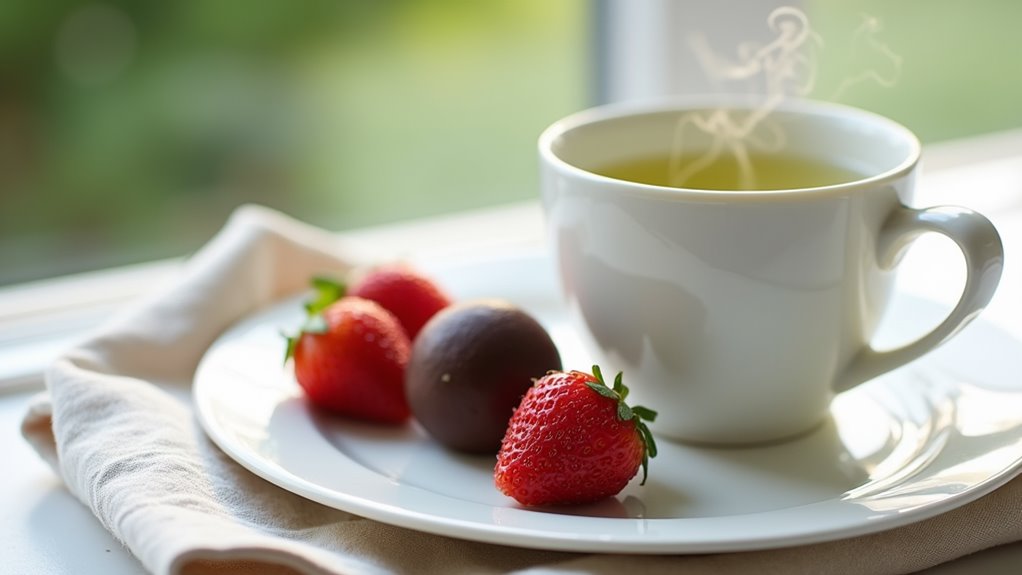
Why do so many of us feel guilty about enjoying life's pleasures? You've likely experienced that nagging voice telling you that indulgence equals irresponsibility, but this mindset can lead to unhealthy relationships with food, rest, and enjoyment.
You can embrace pleasure without compromising your well-being by understanding the difference between mindful and mindless indulgence. When you savor that piece of chocolate or take an afternoon nap, you're not betraying your health goals – you're honoring your body's natural desires.
The key lies in presence and awareness. Notice how certain pleasures make you feel, both during and after. By paying attention to these responses, you'll naturally gravitate toward indulgences that genuinely nourish your body and spirit.
The Science Behind Mindful Indulgence
Your brain releases a cocktail of feel-good chemicals when you indulge in pleasurable activities, including dopamine and serotonin that create natural reward pathways.
You'll find greater satisfaction and better control by mastering portion awareness techniques, such as using smaller plates or taking deliberate pauses between bites.
When you understand these biological responses and practice mindful consumption, you can break free from the destructive cycle of guilt that often follows moments of pleasure.
Brain Chemistry During Pleasure
When we experience pleasure, our brains release a cocktail of neurotransmitters that create feelings of happiness and satisfaction. The key players in this chemical symphony are dopamine, serotonin, and endorphins, each serving a unique role in your pleasure response.
Dopamine surges when you anticipate and experience rewards, driving you to seek out pleasurable experiences. It's the reason you feel excited before taking that first bite of chocolate or starting a new hobby.
Serotonin helps regulate your mood and contributes to feelings of contentment, while endorphins act as natural painkillers and create that warm, fuzzy feeling you get after exercise or laughter.
Understanding these chemical reactions can help you make mindful choices about indulgence, recognizing how your brain responds to different sources of pleasure.
Portion Control Awareness Methods
Armed with knowledge about your brain's pleasure responses, portion control becomes a powerful tool for maintaining healthy indulgence.
You'll find success by using practical methods like measuring cups, food scales, or the hand-portion technique. Your palm represents a serving of protein, your cupped hand measures carbohydrates, and your thumb indicates fats.
Pre-portioning treats into smaller containers helps prevent mindless eating, while using smaller plates tricks your brain into feeling satisfied with less food.
You can also try the 20-minute rule – wait before getting seconds, as it takes your brain this long to register fullness.
Track your portions using a food diary or smartphone app to build awareness of your eating patterns and identify areas where you can make adjustments.
Breaking Guilt-Pleasure Cycles
Understanding the guilt-pleasure cycle starts with recognizing how your brain processes emotions around food choices. When you indulge, your brain releases dopamine, creating temporary pleasure that's often followed by feelings of shame or regret.
This pattern can lead to a destructive cycle of emotional eating and self-criticism.
You can break this cycle by reframing your relationship with food. Instead of labeling foods as "good" or "bad," focus on balance and mindful consumption. When you choose to indulge, do so intentionally and without judgment.
Savor each bite, acknowledge the pleasure, and move forward without guilt. Practice self-compassion by accepting that occasional indulgence is part of a healthy lifestyle.
This mindset shift helps you maintain a sustainable approach to eating that nurtures both body and mind.
Social Media's Impact on Choice
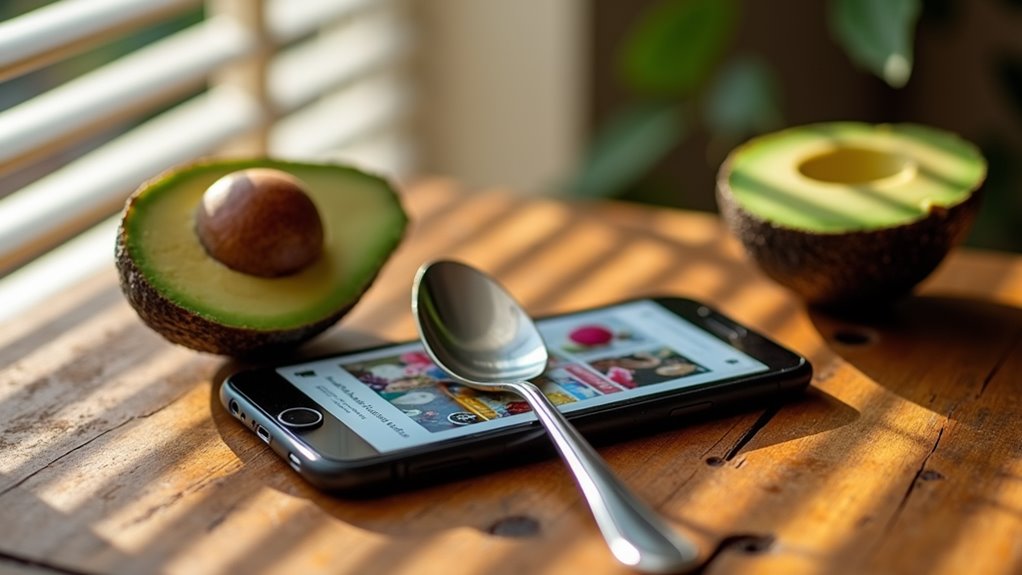
Although social media can inspire healthy lifestyle choices, it often leads people down a path of unrealistic expectations and unhealthy comparisons.
You'll find your feed filled with perfectly staged meals, workout routines, and wellness products that may not align with your personal needs or lifestyle.
When you're constantly exposed to curated content, it's easy to lose sight of what healthy indulgence means for you.
Instead of following trending diets or fitness challenges, focus on developing a balanced relationship with social media.
Turn off notifications during meals, limit your exposure to content that triggers unhealthy behaviors, and follow accounts that promote realistic wellness goals.
Remember that your journey toward healthy living shouldn't be dictated by likes, shares, or the latest viral health trends.
Creating Sustainable Lifestyle Habits
You'll find that small daily adjustments to your routine can create meaningful lifestyle improvements without overwhelming changes.
When you're mindful about planning each day's activities and choices, you're building stronger habits that will serve you well into the future.
Your consistent, modest steps toward better health and wellness add up quickly, creating sustainable changes that feel natural rather than forced.
Small Changes, Big Impact
When making significant lifestyle changes, starting small creates lasting success. You'll find that minor adjustments to your daily routine can lead to remarkable transformations over time. Instead of overhauling your entire lifestyle at once, focus on implementing one manageable change each week.
Begin with simple swaps like taking the stairs instead of the elevator or adding one extra vegetable to your dinner plate. These small victories build confidence and momentum, making it easier to tackle bigger challenges later.
You'll notice that these modest modifications naturally evolve into lasting habits without overwhelming you. As these changes become second nature, you can gradually introduce new ones, creating a sustainable path to better health that fits seamlessly into your life.
Mindful Planning Every Day
Building on these small changes requires thoughtful daily planning to make them stick.
You'll find success by setting aside 10 minutes each evening to map out tomorrow's healthy choices. Start with scheduling your meals, exercise, and rest periods, then work other activities around these essential pillars.
Keep a simple journal to track your progress and adjust your plans when needed. You don't have to be perfect – aim for consistency rather than perfection.
When you encounter obstacles, treat them as learning opportunities rather than failures. Create reminders on your phone, leave notes in strategic places, and enlist support from family or friends.
Redefining Modern Wellness Standards
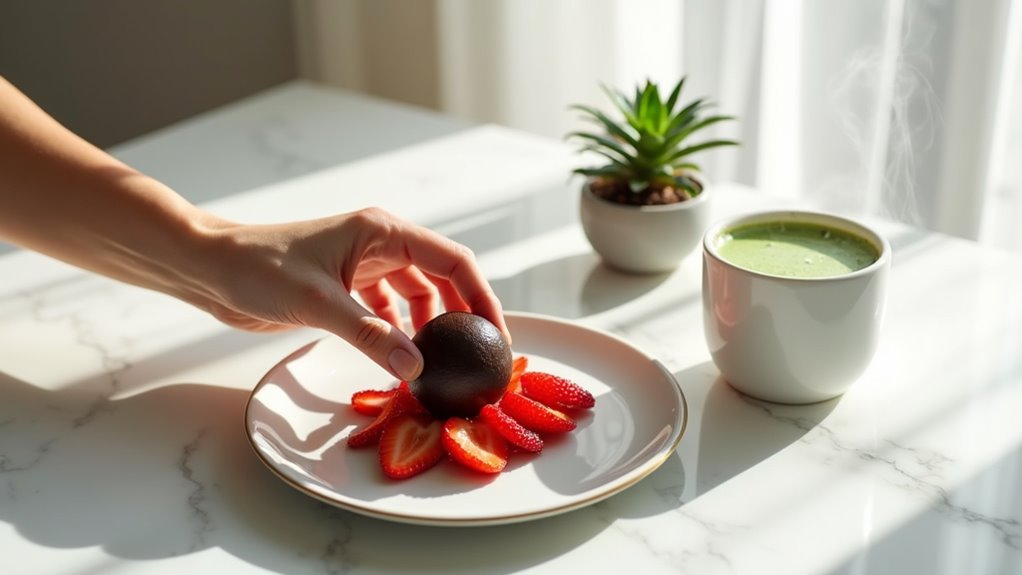
As wellness trends continue to evolve, today's standards are shifting away from rigid rules toward a more balanced and sustainable approach.
You'll find that modern wellness embraces flexibility, acknowledging that health isn't a one-size-fits-all journey.
You can now focus on what truly works for your lifestyle instead of following strict diets or intense workout regimens. This means enjoying occasional treats without guilt, choosing movement that brings you joy, and prioritizing mental well-being alongside physical health.
You're encouraged to listen to your body's signals, respect your natural rhythms, and make choices that support long-term vitality rather than quick fixes.
The new wellness paradigm empowers you to create sustainable habits while honoring your individual needs and circumstances.
Finding Your Personal Balance
Discovering your unique wellness rhythm starts with understanding that balance looks different for everyone. Your personal equilibrium emerges from the intersection of your lifestyle, commitments, and priorities.
Start by assessing your current habits and energy levels throughout the day. Notice when you feel most focused, energized, or drained. You'll find patterns that reveal your natural tendencies and needs. Consider your non-negotiables – those activities or moments that truly matter to you.
Next, experiment with different routines and self-care practices. Maybe you thrive with morning meditation, or perhaps evening walks help you decompress.
Don't force yourself to follow trendy wellness practices that don't align with your schedule or preferences. Instead, create sustainable habits that fit naturally into your daily life.
Building Long-term Health Relationships
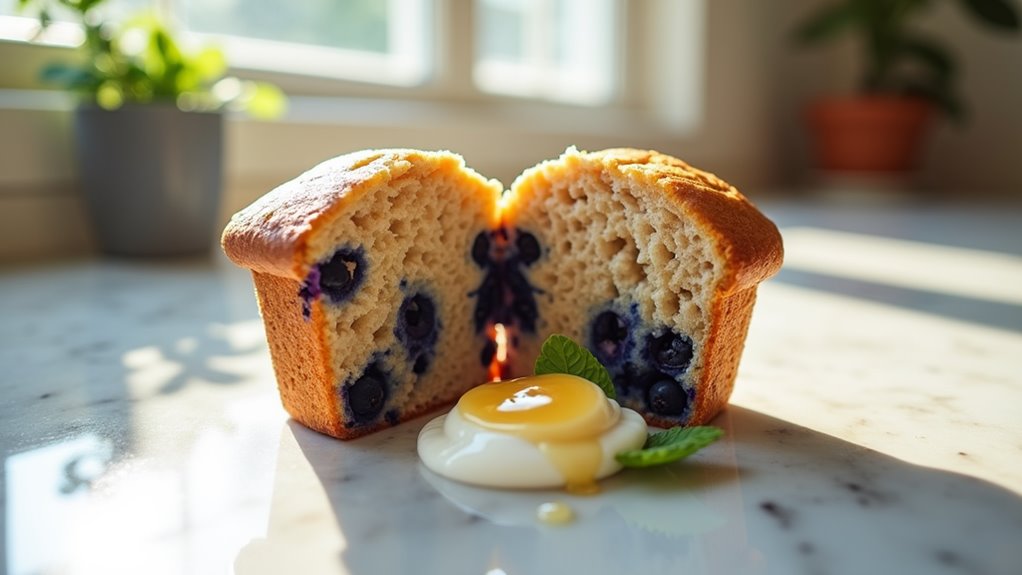
Long-term wellness depends on cultivating meaningful relationships with healthcare providers, fitness experts, and wellness mentors who understand your goals.
You'll want to find professionals who listen actively, respect your preferences, and support your health journey while challenging you to grow.
Start by researching potential providers and scheduling initial consultations.
Don't hesitate to switch if someone isn't the right fit – chemistry and communication matter.
Once you've found your team, maintain regular contact and be honest about your challenges and successes.
Keep detailed records of your health history, medications, and lifestyle changes to share with your providers.
Remember to leverage technology – many health professionals now offer virtual consultations, app-based monitoring, and digital communication options to help you stay connected and accountable.
Frequently Asked Questions
How Can I Indulge During Social Events Without Derailing My Health Goals?
You can enjoy social events while staying on track by following the 80/20 rule – eat well 80% of the time and relax for the other 20%.
Choose your indulgences wisely, focusing on foods you truly love. Eat a small healthy meal before events, drink water between alcoholic beverages, and position yourself away from the snack table to avoid mindless grazing.
Can Genetic Factors Influence How We Respond to Different Indulgences?
Yes, your genes significantly influence how you respond to different indulgences.
You'll metabolize alcohol, caffeine, and sugar at different rates based on your genetic makeup. Your DNA also affects your taste preferences, addiction susceptibility, and how quickly you feel satisfied.
Some people are naturally more sensitive to bitter flavors, while others might've genes that make them crave sweets more intensely.
What Role Does Childhood Upbringing Play in Our Relationship With Treats?
Like a blueprint for future habits, your childhood experiences with treats shape your adult relationship with indulgence.
You'll often mirror your parents' attitudes – whether they used sweets as rewards, comfort, or occasional pleasures. If they restricted treats heavily, you might rebel or develop strict control patterns.
If they taught balanced enjoyment, you're more likely to maintain a healthier approach to treats throughout life.
How Do Cultural Differences Affect Perspectives on Healthy Indulgence Worldwide?
You'll find striking differences in how cultures view indulgence and health.
In Mediterranean regions, you're likely to see regular wine consumption paired with long, social meals.
Asian cultures often emphasize balance and moderation, treating sweets as occasional small portions.
While Western societies might struggle with portion control, you'll notice other cultures naturally integrate treats into daily life without guilt, making indulgence feel more sustainable and healthy.
When Does Mindful Indulgence Become a Form of Disordered Eating?
Mindful munching morphs into disordered eating when you're constantly consumed by thoughts of food and control.
You'll notice red flags if you're rigidly tracking every bite, feeling guilty after any treat, or letting food choices dictate your social life.
It's concerning when your "healthy" habits lead to anxiety, isolation, or obsessive behaviors.
Trust your gut – if you're worried, reach out to a healthcare professional.
Conclusion
Like a skilled trapeze artist, you'll find your sweet spot between discipline and delight. Life's a tightrope walk – one where you're learning to dance between health-conscious choices and life's little pleasures. You're not aiming for perfection; you're creating your own circus act of balanced living. When you embrace both wellness and joy, you'll discover there's room for both in your center ring.
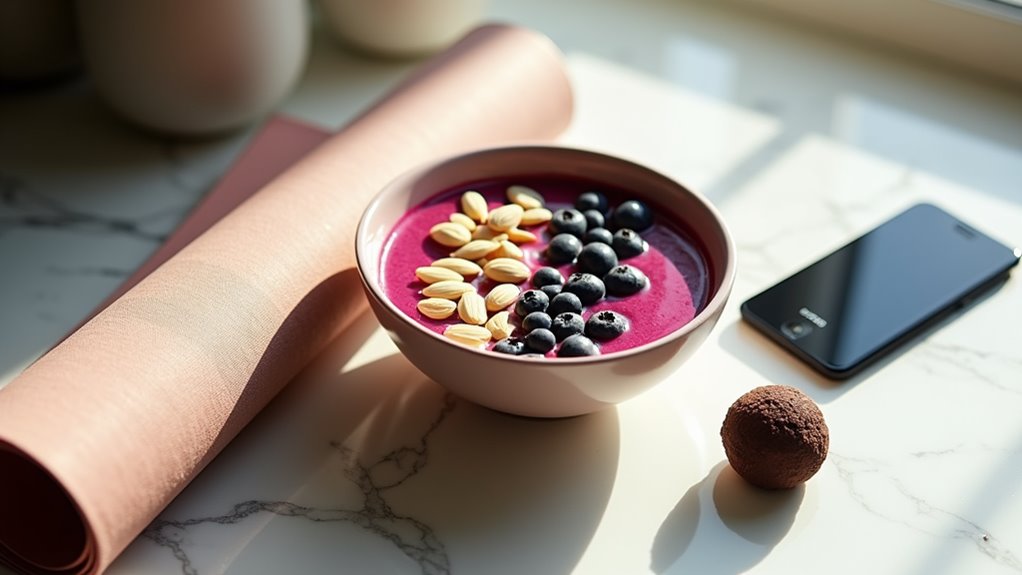
Leave a Reply